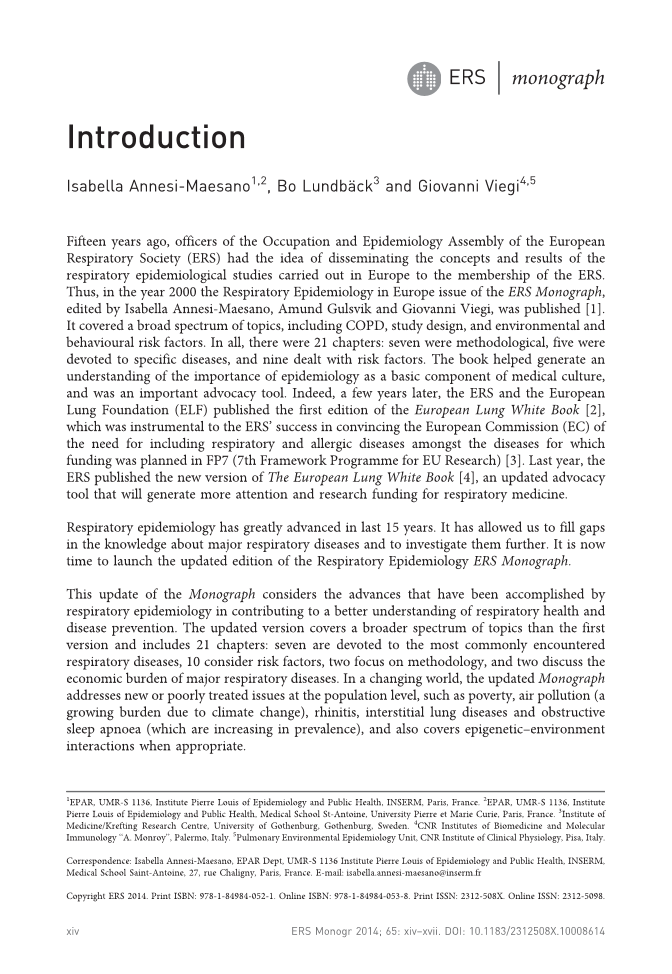ERS | monograph Introduction Isabella Annesi-Maesano1,2, Bo Lundback3 ¨ and Giovanni Viegi4,5 Fifteen years ago, officers of the Occupation and Epidemiology Assembly of the European Respiratory Society (ERS) had the idea of disseminating the concepts and results of the respiratory epidemiological studies carried out in Europe to the membership of the ERS. Thus, in the year 2000 the Respiratory Epidemiology in Europe issue of the ERS Monograph, edited by Isabella Annesi-Maesano, Amund Gulsvik and Giovanni Viegi, was published [1]. It covered a broad spectrum of topics, including COPD, study design, and environmental and behavioural risk factors. In all, there were 21 chapters: seven were methodological, five were devoted to specific diseases, and nine dealt with risk factors. The book helped generate an understanding of the importance of epidemiology as a basic component of medical culture, and was an important advocacy tool. Indeed, a few years later, the ERS and the European Lung Foundation (ELF) published the first edition of the European Lung White Book [2], which was instrumental to the ERS’ success in convincing the European Commission (EC) of the need for including respiratory and allergic diseases amongst the diseases for which funding was planned in FP7 (7th Framework Programme for EU Research) [3]. Last year, the ERS published the new version of The European Lung White Book [4], an updated advocacy tool that will generate more attention and research funding for respiratory medicine. Respiratory epidemiology has greatly advanced in last 15 years. It has allowed us to fill gaps in the knowledge about major respiratory diseases and to investigate them further. It is now time to launch the updated edition of the Respiratory Epidemiology ERS Monograph. This update of the Monograph considers the advances that have been accomplished by respiratory epidemiology in contributing to a better understanding of respiratory health and disease prevention. The updated version covers a broader spectrum of topics than the first version and includes 21 chapters: seven are devoted to the most commonly encountered respiratory diseases, 10 consider risk factors, two focus on methodology, and two discuss the economic burden of major respiratory diseases. In a changing world, the updated Monograph addresses new or poorly treated issues at the population level, such as poverty, air pollution (a growing burden due to climate change), rhinitis, interstitial lung diseases and obstructive sleep apnoea (which are increasing in prevalence), and also covers epigenetic–environment interactions when appropriate. 1 EPAR, UMR-S 1136, Institute Pierre Louis of Epidemiology and Public Health, INSERM, Paris, France. 2 EPAR, UMR-S 1136, Institute Pierre Louis of Epidemiology and Public Health, Medical School St-Antoine, University Pierre et Marie Curie, Paris, France. 3 Institute of Medicine/Krefting Research Centre, University of Gothenburg, Gothenburg, Sweden. 4 CNR Institutes of Biomedicine and Molecular Immunology ‘‘A. Monroy’’, Palermo, Italy. 5 Pulmonary Environmental Epidemiology Unit, CNR Institute of Clinical Physiology, Pisa, Italy. Correspondence: Isabella Annesi-Maesano, EPAR Dept, UMR-S 1136 Institute Pierre Louis of Epidemiology and Public Health, INSERM, Medical School Saint-Antoine, 27, rue Chaligny, Paris, France. E-mail: isabella.annesi-maesano@inserm.fr Copyright ERS 2014. Print ISBN: 978-1-84984-052-1. Online ISBN: 978-1-84984-053-8. Print ISSN: 2312-508X. Online ISSN: 2312-5098. xiv ERS Monogr 2014 65: xiv–xvii. DOI: 10.1183/2312508X.10008614
